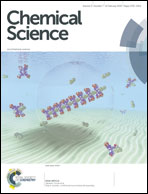[(Cp2M)2B9H11] (M = Zr or Hf): early transition metal ‘guarded’ heptaborane with strong covalent and electrostatic bonding†‡
Abstract
Among the series of stable closo-borate dianions, [BnHn]2−, the X-ray crystallographic structure of [B7H7]2− was determined only in 2011. To explore its chemistry and stability, we have isolated and structurally characterized two new transition metal complexes of the heptaborane, [(Cp2M)2B9H11] (Cp = η5-C5H5; M = Zr or Hf). The structures of [(Cp2M)2B9H11] contain a pentagonal bipyramidal B7 core, coordinated by two {Cp2M} and two {BH2} units equatorially. Structural and spectroscopic characterizations and DFT calculations show that [(Cp2M)2B9H11] complexes are substantially more stable than the parent dianion, in either [B7H7]2− or (nBu4N)2[B7H7]. Our theoretical study and chemical bonding analyses reveal that the surprising stability of the two new heptaborane metal complexes is due to multi-center covalent bonds related to the two exo-{Cp2M} units, as well as electrostatic interactions between the {Cp2M} units and the B7 core. The facile syntheses of the heptaborane metal-complexes will allow further exploration of their chemistry.
![Graphical abstract: [(Cp2M)2B9H11] (M = Zr or Hf): early transition metal ‘guarded’ heptaborane with strong covalent and electrostatic bonding](/en/Image/Get?imageInfo.ImageType=GA&imageInfo.ImageIdentifier.ManuscriptID=C7SC05014C&imageInfo.ImageIdentifier.Year=2018)


 Please wait while we load your content...
Please wait while we load your content...